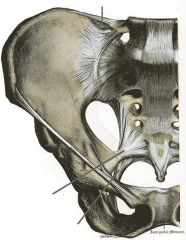![]()
![]()
![]()
Use LEFT and RIGHT arrow keys to navigate between flashcards;
Use UP and DOWN arrow keys to flip the card;
H to show hint;
A reads text to speech;
23 Cards in this Set
- Front
- Back
|
Musculoskeletal System:
Lec.21B - Rehabilitation Medicine - Tendon and Lig Dysfunction |
Musculoskeletal System:
Lec.21B - Rehabilitation Medicine - Tendon and Lig Dysfunction |
|
|
Q21B:
Musculoskeletal ultra sound, is it any good? |
yes, it can often give you information that even an MRI can not give you
|
|
|
Q21B:
what is a strain? tendinitis? Tendinosis? Tendinopathy? |
- Injury to tendon
- inflammation of tendon - chronic degeneration, DISTINCT LACK OF INFLAMMATORY CELLS(more accute term for chronic injury) - any disorder of the tendon |
|
|
Q21B:
What is enthesis? |
insertion site of tendon, ligament, fascia, or articular capsule into bone
|
|
|
Q21B:
What is an enthesopathy? |
- any disorder of the enthesis
|
|
|
Q21B:
Enthesitis? |
inflammation of enthesis (common in rheumatic disorders)
|
|

Q21B:
Name the ligaments indicated by the thick Grey lines |

- iliolumbar lig
-sacrotuberous lig - sacrospinous ligaments |
|
|
Q21B:
What are the common enthesopathies of the spine / SI region? |
-Iliolumbar ligament
-Posterior sacroiliac ligaments -Sacrotuberous ligament -Gluteal tendons -Hip adductor tendons |
|
|
Q21B:
What are the most common enthesopathies? |
Rotator cuff
-Lateral epicondyle of humerus -Lower pole of patella -Achilles tendon insertion -Plantar fascia of the heel |
|
|
Q21B:
how common are tendon or ligament injuries? |
100 million musculoskeletal injuries occur annually worldwide, 30-50% involve tendon or ligament injury
|
|
|
Q21B:
what sorts of pertinent history is there for tendon and or ligament dysfunction? |
- trauma
- joint subluxation / dislocation - polyarthralgia - pain upon awakening and after physical activity - pseudoradicular symptoms with negative imaging, EMG and / or poorly responsive to spinal injections - OMT does not hold or makes a problem worse - joint hypermobity - Local tenderness usually at entheses (with or without referred pain along the pseudoradicular distribution) - Exacerbation of pain with active resistance and or passive stressing of the muscle tendon unit - myfacial dysfunctoin (with trigger points in muscles supporting a relatively lax joint) - joint hypermobility (often masked by muscle spasm) as determined by the beighton hypermobility score |
|
|
Q21B:
What is pain referral pattern for the iliolumbar ligament> |
- into the groin and latteral hip
|
|
|
Q21B:
What is the pain referral pattern for the posterior sacroiliac ligament/ |
- posterior and anterior thigh
|
|
|
Q21B:
What is joint hypermobility syndrome? |
- 4-13% of general population
- women > men |
|
|
Q21B:
What is the brighton hypermobility score? |
- 9 points max (>4 = major criterion <4 = minor criterion)
- lumbar flexion = 1pt -elbow flexion =1pt knee hyperflexion = 1pt wrist flexion = 1pt 5th finger hyperflexion= 1pt |
|
|
Q21B:
What are two common pain disorders around the hip |
- Sacroilitis
- Trochanteric bursitis |
|
|
Q21B:
SI joint problem vs SI ligament problem? |
Usually a ligament problem, not a joint problem
|
|
|
Q21B:
what are two important components of inflamation> |
- pain (so that you will stop reinjuring it)
- inflamation = healing process (if we interupt inflammation then we interupt the healing process) |
|
|
Q21B:
if you use NSAIDs soon after a Fx, what will happen? |
-it will decrease the healing of the Fx
|
|
|
Q21B:
Where have steroids been shown to notabally aid in the reduction of chronnic inflammation of tendon lesions? |
- Trigger finger
|
|
|
Q21B:
what will ECCENTRIC strengthening help with? |
-reduction of pain and reduction of swelling in lower extremity tendenopathy.
|
|
|
Q21B:
Prolotherapy? |
-"proliferative therapy"
- “Method of injection treatment designed to stimulate healing. Various irritant solutions are injected into the ligaments, tendons, and joints to encourage repair of damaged tissue” - hyperosmolar dextrose (one of the best injections |
|
|
Q21B:
Platelet-Rich Plasma (PRP) injection therapy |
- injections of autologous plasma rich in platelets and growth factors into dysfunctional tissue (about 3x more powerful than prolotherapy, only been in use for about 5 years)
|

